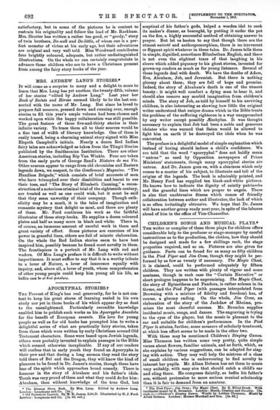MRS. ANDREW LANG'S STORIES.* IT will come as a surprise
to many and a delight to more to learn that Mrs. Lang has yet another, the twenty-fifth, volume of her stories "edited by Andrew Lang." Last year her Book of Saints and Heroes seemed likely to be the last con- nected with the name of Mr. Lang. But since he loved to prepare full measure, pressed down and running over, enough stories to fill this year's ample volume had been chosen and worked upon while the happy collaboration was still possible. The great feature of these five-and-thirty stories is their infinite variety. To trace them all to their sources would be a fine test of width of literary knowledge. One of them is easily traced, being a charming animal story signed with Miss Elspeth Campbell's initials. Nearly a dozen Red Indian fairy tales are acknowledged as taken from the Tlingit Stories published by the Smithsonian Institution. There are other American stories, including Rip Van Winkle. Four are taken from the early parts of George Sand's .Flistoire de ma Vie. Other sources appear to range from old chronicles and Eastern legends down, we suspect, to the Gentleman's Magazine. "The Handless Brigade," which consists of brief accounts of men who have triumphed over their disabilities and learnt to use their toes, and "The Story of Elizabeth Canning," a recon- struction of a notorious criminal trial of the eighteenth century, are treated as well as one could wish, but it must be said that they seem unworthy of their company. Though cath- olicity may be a merit, it is the tales of imagination and romantic mystery that delight us most, and there are plenty of these. Mr. Ford continues his work as the faithful illustrator of these story-books. He supplies a dozen coloured plates and half as many more in black and white. There is, of course, an immense amount of careful work in them and great variety of effect. Some pictures are exercises of his power in graceful lines, others are full of minute elaboration. On the whole the Red Indian stories seem to have best inspired him, possibly because he found most novelty in them. The frontispiece is a portrait of Mr. Lang with rod and waders. Of Mrs. Lang's preface it is difficult to write without impertinence. It must suffice to say that it is a worthy tribute to a lover of Nature, a lover of innocence equally with inquiry, and, above all, a lover of youth, whose comprehension of other young people could keep him young all his life, as befits one tee 01 °fel itexagly.






























































 Previous page
Previous page